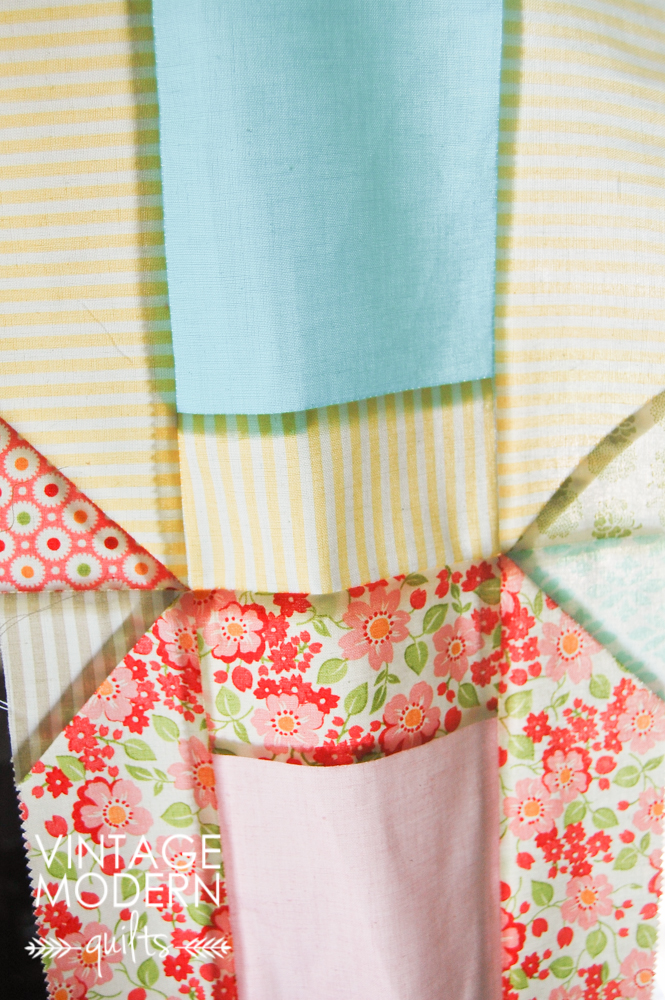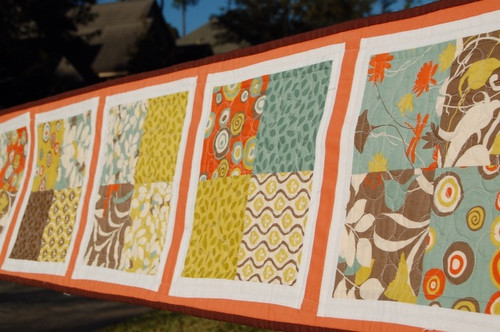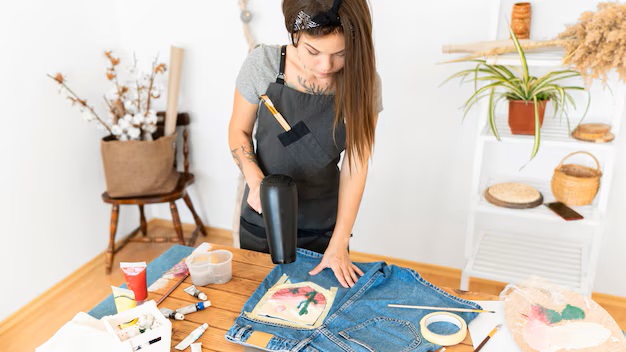Learn to Quilt: Piecing Part 2
This post is part of my Learn to Quilt series. You can find all related posts {here}.
Today I’m back (finally!) finishing up Part 2 of piecing your quilt top. The pattern we are using has excellent instructions on putting together the rows, but I’d like to add a few tips to get your points perfectly matched. I’ll also go through the steps for adding borders. This post is long so grab a snack and hunker down.
MATCHING POINTS
1. Square up your blocks (in this case, rectangle up your blocks!) before you start piecing the top. Blocks should measure 12 1/2″ x 8 1/2″ with seams. Normally I’d use a quilting square that measures the same size (or close to) the size of my unfinished block. Since these blocks are rectangular, I used my 6″x24″ ruler to square them up. To do this, use the seam as your measuring point…our 2.5″ strips are now 2.25″ wide since we’ve sewn one seam:
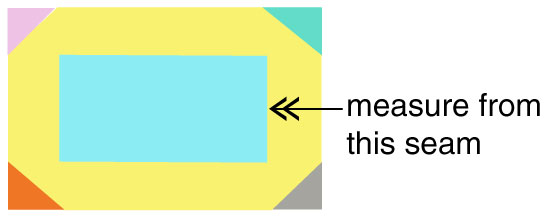
Set your ruler so that the 2 1/4″ mark falls on the seam. The right edge of the ruler should be just about even with the edge of your block. Trim off any excess.
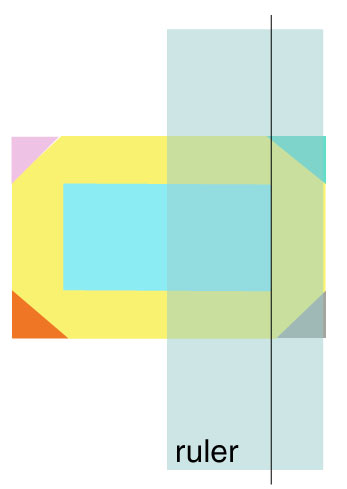
Flip your block clockwise to the next seam and repeat. Do this for all four sides.
Squaring up is tedious and it can be a major PITA. But don’t skip it. It can make a big difference in the final product. Make it a part of your process to square up at every step of piecing – smaller block units and the final block.
2. When joining blocks or block segments where your seams will meet up, PIN! Use Clover fork pins and make those seams match. Sometimes you will have to gently stretch the fabric to make your points match. In the photo below, you can see my two blocks pinned together, with the seams pressed in opposite directions.
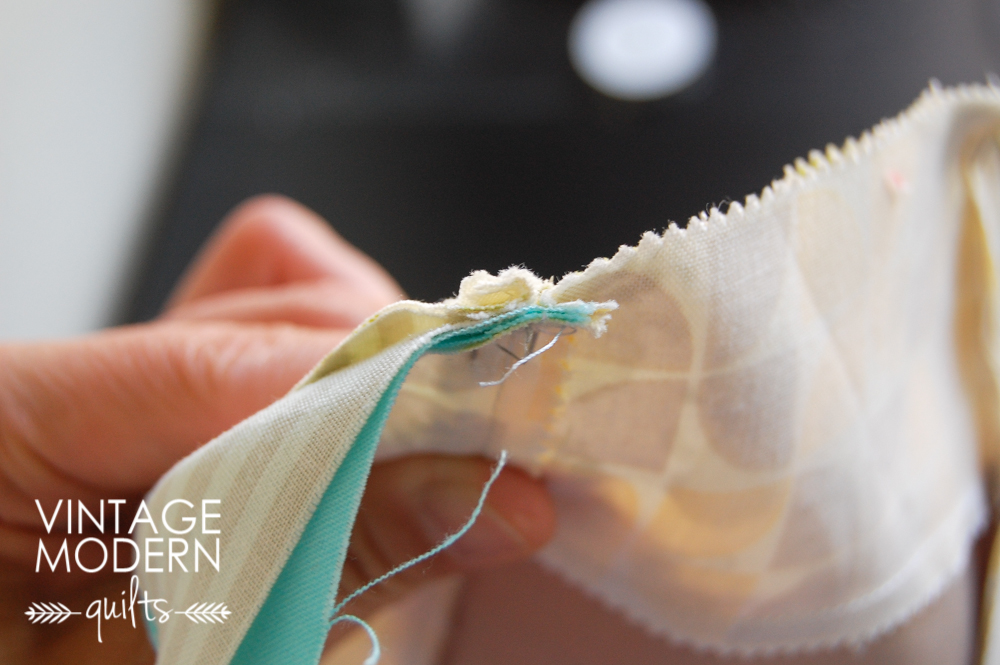
3. Thoroughly press every seam. I press from the top because I get a flatter seam that way, but if pressing from the back works for you, do that. Use a bit of starch and a HOT iron.
ADDING BORDERS
Borders are the red-headed step child of the modern quilting world. Dated, grandma-ish…they are just uncool to most modern quilters. I don’t often add borders, but sometimes they’re nice to frame the piecing. I also add borders in a situation like this quilt top where the points on my blocks would be covered by the binding if I went border-less. To modernize the borders on this quilt, I’m using the same color for both and it’s meant to act more as a background than a frame. The piecing will look like it’s floating.
Now that we’ve covered Quilt Border Philosophy 101, let’s talk about how you add them. You could just cut fabric a little bit longer than the side of your quilt and lop off the extra. The quilt police will come and arrest you for that, though, so watch out. Our quilt top has two borders – an inner one pieced like a block and the outer one that is a typical border. Piece your inner border according to the pattern instructions and then come back here for your outer border.
The proper method for adding borders is:
1. Get out that calculator and do some math. The formulas are simple:
Finished Block Height x No. of Vertical Blocks + Inner Border Width = Quilt Top Height
8″ x 8 + 2 1/4″ = 66 1/4″ (Note that at this stage our inner border still has one unfinished seams so we need to keep that measurement at 2 1/4″ instead of the finished size of 2″.)
Finished Block Width x No. of Vertical Blocks + Inner Border Width = Quilt Top Width
12″ x 5 + 2 1/4″ = 62 1/4″ (Again, we are keeping that unfinished 1/4″ seam in the calculation)
(Quilt Top Height x 2) + (Quilt Top Width x 2) + (Semi-Finished Border Width x 4) = Total Border Length
(66 1/4″ x 2) + (62 1/4″ x 2) + (6.25″ x 4) = 282 inches
If this makes your head explode, use a quilting calculator. They’ll do all of that math for you, but you’ll still have to measure/calculate the height and width of your quilt top. Calculations are more accurate than measuring, but if you’d rather get out the yard stick, measure from the center of the quilt top, not the edges.
2. Prep your border fabric. Cut WOF x width of your desired border. Our border is 6 1/2″ wide and we need 282 total inches + seams. Let’s do one more calculation:
Total Border Length/Useable Fabric Width = Number of Strips to Cut + Overage for Seams
282/43 = 6.55
Round up and cut 7 strips WOF x 6.5″.
3. Trim off the selvedges (you can do this before you cut the strips) and sew your border strips end-to-end. You’ll have a total length of about 301 inches.
4. Cut your side border strips to your calculated quilt height from step 1 – 66 1/4″. Sew these on to your quilt top sides.
5. Cut your top and bottom border strips to calculated quilt width from step 1 (62 1/4″) plus border width we just added (6 1/4″) times two – 74 3/4″.
Why all the fuss about borders? You can add a lot of bulk to your quilt top if you attach borders using the “lop off” method (Exihibit A, B, and C). Notice that all of those examples are on long arms….wavy/bulky/bacon-y borders are at their worst on a long arm. The rollers on the long arm pull the fabric taut so any flaws are magnified. A good long arm quilter can work in the fullness but they will probably say ugly cuss words about you while they’re doing it.
Border bulk is not as bad when you are basting the old-fashioned way at home because you can smooth and stretch the fullness out as you baste. But proceed with caution, because that stretching and smoothing may show up in the final quilt as wonky edges or a quilt that you have to trim down excessively to hide the imperfections. As my Mamaw (and probably lots of people’s mamaws) would say, you can’t make a silk purse out of a pig’s ear. It’s easier to do it properly than to fix a wonky, wavy mess.
See you next Monday for part 8 – Learn to Quilt: Basting.

